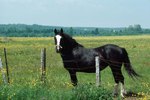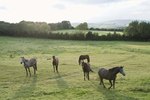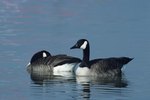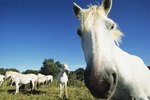
Horses are not monogamous animals, and pairs of horses do not establish lifelong relationships. Instead, horses do form long-term relationships within groups, called herds. The mature animals that form the core population of the herd interact based on gender and rank. Offspring of the herd members are usually driven out between the ages of 2 and 5 years. These horses will form their own herds or join other, already established herds.
Horse Family Units
Typical horse herds develop as territorial, mixed-gender groups that facilitate reproduction and aid in the security of its members. Herds are composed of one or more stallions, a number of mature mares, and immature male and female offspring called colts and fillies. Bachelor bands, groups made up of male offspring that have been driven from their herds, will also form as social groups. The colts and mature stallions that form these groups establish a structure based on dominance. The most dominant males in these groups are typically those who will be first to attract mates. Dominant males only retain their leadership roles for about two years, although stallions physically capable of fulfilling those roles can remain the harem leader for much longer. Stallions supplanted from their position are often replaced by stallions from bachelor bands.
Harem Formation
Horses instinctively seek herd membership for reproductive purposes and for security. New harems form when fillies that have been separated from their natal herds join bachelor bands. These fillies form long-term bonds with one of the males in the herd, most often the dominant male of the group. Mares tend to choose to remain in or to leave a harem based on the resources available within their territory, not based on attraction to the males in the herd.
How Horses Select Mates
Horses are seasonal, long-daylight breeders. Mares come into estrus, their fertile period, during the spring and summer months. Mares and fillies as young as 2 or 3 years of age will enter estrus and present themselves to other horses in the herd, signaling their readiness to breed. Mares will remain in estrus for approximately a week. They will enter estrus every three weeks until they become pregnant or until the daylight periods shorten.
Stallions are attracted to mares in estrus both by their scent and by social cues such as nuzzling and nickering. Stallions may choose mares based on their ability to produce foals that will survive. This success is related to the mare’s ability to provide sufficient resources to the foal rather than age or rank. The dominant stallion will usually be the one to breed the harem mares. However, horses in a feral herd resist breeding with familiar mares or stallions. If the stallion knows the mare in estrus to be a member of her natal band -- or vice versa -- then both the stallion and the mare will avoid mating, reducing the possibility of inbreeding. In such cases, mares may be bred by the secondary stallions in the band.
Domestic Horse Herds
Domestic horse herds often have similar structure to those found in the wild. When mixed-gender groups are pastured together, geldings may take on stallion-like behaviors in the presence of a mare in estrus. They may attempt to mount and breed such mares or take on the protective behavior of the absent stallion. This behavior is particularly common when the gelding has been castrated after reaching sexual maturity.
References
Photo Credits
-
John Foxx/Stockbyte/Getty Images




